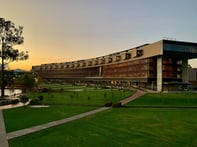Published on
Fast Forward: Looking to the Future Workforce and Online Learning

With employers and students looking to close the gap in workforce skills, it’s critical for them to know what skills are in need the most. Postsecondary institutions need to be the resource to provide learners with the education the workforce needs and to make both parties understand the value of the students’ education. With the remote and online shift, it’s a new territory for institutions handle. In this interview, Joann Kozyrev discusses the impact remote learning has on an online institution, concerns about the future of online learning and how to get people back into the workforce fast and efficiently.
The EvoLLLution (Evo): Do you think some of the innovations and tools that have been introduced to support this shift to remote education will be adopted into our post-pandemic new normal?
Joann Kozyrev (JK): Western Governors University (WGU) has the good fortune to have always been online, and what we are now doing is refining the space in which we operate. There are a lot of ways in which we want to continuously improve, so our students have the best possible experience.
We have discovered that our students’ needs are different now. So, we’re actually planning to continue some of the changes we’ve made once pandemic restrictions ease. In other cases, we’re accelerating plans that we already had made in order to move to a more skills-driven curriculum. A skills-driven curriculum will help us reach a few goals.
One of those goals is to more tightly align our curriculum with labor marketplace needs. The second is making it easier for students to pause their studies when life intervenes while ensuring they earn incremental value along a “stackable” path to a credential. One thing that’s become clear to us is that some students have more time and motivation behind completion right now, other students will need more time than they expected, and both groups need help to stay on track. The third goal is making sure the credentials offered at those stopping points are useful in the marketplace. Some students are going to need fast fixes.
Evo: Are you concerned that that next generation of lifelong learners are going to equate online learning to that experience they had when they were 18 during this crisis?
JK: It’s not that we’re worried, but that we’re aware that this will happen. This is a flashbulb memory moment for everyone, and it will influence anybody who’s having their early experiences with online learning now. I’m hearing parents say this is harder than it needs to be, and students know it could be better. But I’m also hearing that students are seeing value in online learning that perhaps they didn’t before.
We’re going to have to tap into the advantages they’re seeing. We’re going to see them become more independent learners because they’re having to solve problems for themselves. There’s a lot of confusion around how to assess students with integrity in this new environment since educators can’t always assess them in the ways that they are used to. Competency-based education and assessment, online proctoring, performance assessment and other methods can solve that.
Evo: How should universities be preparing for the increase in demand that so typically follows mass unemployment?
JK: One of the foundational rules of curriculum and program design is to begin at the end–a backwards design. We need to stop and ask ourselves what the needs are of someone who was forced into unemployment and how they differ from someone just actively wanting to make a change. We need to listen to them and learn what it is they’re going to need most. Sometimes, we’ll have to figure that out ourselves, and other times they’ll tell us. Then we’ll have to look at our systems to see what prevents them from learning and try to remove those blockers.
If the blocker is a lengthy approval or course creation process, can we give a task force the authority to come up with a quick solution? What tools do we have at hand to curate instead of create? Is there a partnership that can help us look at what these students need, pinpoint where the blockers are and respond to them while keeping our commitment to integrity and quality intact?
Evo: What lessons do you think higher ed leaders could draw from the experience of the 2008 recession or do you think it’ll be completely different?
JK: At that time, I was in a very different role—in industry. What I found to be the same was that it was rather sudden. In hindsight, we should have seen it coming, but we didn’t. What’s common is that student motivations change, and industry needs change. So, we need to take a moment to analyze needs and reimagine how higher ed can be a connector that brings solvers together.
Evo: How do you see postsecondary institutions as a connector?
JK: It’s very much the way we see our curriculum at WGU. We’re interested in closing the skills gap, in helping people increase their satisfaction with their work and learning. We’re interested in helping them increase the socioeconomic impact that their learning has on their lives and those of their families.
For that reason, I see us as a connector. In my own personal experience, my education has very much connected me to other people, to opportunity, to a world I wouldn’t have otherwise seen or known. We all hope to do that for our students.
Evo: What kinds of programmatic innovations are you guys looking at to help people get back into the workforce as quickly as possible?
JK: One that comes to mind is basing our curricular development on skills so that the pathways we’re offering are more clearly and quickly aligned with the career opportunities learners are seeking.
We also want to help students communicate better about their own skillsets and describe what they learned. Going to a job interview and talking about the courses you passed is helpful but only if you or the interviewer can connect those courses to workplace applications. If we do a better job of surfacing those career insights to our students, they can better tell their own story.
We can also do a better job of keeping employers informed of the skillsets their employees need. Employers think in terms of skills, so we can better point them towards the preparatory programs and the graduates that can most quickly fulfill their needs. The faster we can do that, the faster someone can earn money to care for their family, and that money flows back into the economy.
Evo: Is there any advice you might like to share for other institutional leaders who are trying to figure out how to shape their institutions to meet the needs of a vastly and quickly changing environment?
JK: When I consider my own transformation in terms of how to solve problems like this, I had to learn to ask: how do you get out of incumbent thinking when it won’t solve the problem? My answer is that you have to first identify the obstacles you face and the tools you need in order to get past the obstacles. If we can’t change the direction of the wind, then we need to put up a few trial balloons and test some things out.
This interview was edited for length and clarity.
Editor’s note: This interview was recorded on April 21, 2020.
Author Perspective: Administrator



